
table of contents
- Types A - E
- Types of F - G
- Species with H
- Types from I - R
- Types with S
- Types from T - Z
- frequently asked Questions
Shady locations are often difficult to green, and it is particularly difficult to find flowering, hardy plants. There are some perennials that can conjure up a lush display of flowers in this location too.
In a nutshell
- Woodruff and evergreens are easy to care for ground cover in a shady location
- Species like the bergenia are evergreen and can turn a shady spot into a green oasis in winter
- Ferns and grasses are easy-care plants in shady locations that have to be pruned no more than once a year
- There are numerous plants for shady locations that bloom profusely in spite of reduced solar radiation
Types A - E
Altai bergenia (Bergenia cordifolia)

- Height: up to 40 cm
- Growth habit: spreading, bushy, forms large clumps
- Required space: 35 cm
- Flower: umbel-shaped, pink
- Flowering period: April - May
- Leaves: oval to heart-shaped, shiny, leathery
- Soil: fresh, nutrient-rich, well-drained
When planting in shady locations, there is no getting around the bergenia. The leaves are evergreen and in early spring it produces attractive flowers.
Trefoil golden strawberry (Waldsteinia ternata)

- Height: up to 15 cm
- Growth habit: flat, creeping, carpet-like
- Space requirement: can take up several square meters in a short time
- Flower: simple, golden yellow
- Flowering period: April - May
- Leaves: tripartite, toothed, hairy
- Soil: well-drained, fresh, moist, humic
Tip: There are few hardy plants that can withstand freezing temperatures as well as the three-leaf golden strawberry. This means that it is also suitable for planting areas that are highly prone to frost.
Real woodruff (Galium odoratum)

- Height: up to 30 cm
- Growth form: upright, flat
- Required space: 20 - 30 cm
- Blossom: umbel-shaped, white, simple
- Flowering period: April - May
- Leaves: lanceolate, whorled
- Soil: well drained, very humic
Elven flowers (Epimedium spec.)

- Height: up to 30 cm
- Growth habit: pillow-like, loose clumps
- Required space: 30 - 40 cm
- Flower: depending on the variety, white, violet, bluish, orange-red
- Flowering period: April - May
- Leaves: depending on concern, green, reddish, red-brown
- Soil: well-drained, fresh, humic moist
The elven flowers live up to their name. The delicate and filigree flowers are particularly effective in a shady location.
European ostrich fern (Matteuccia struthiopteris)
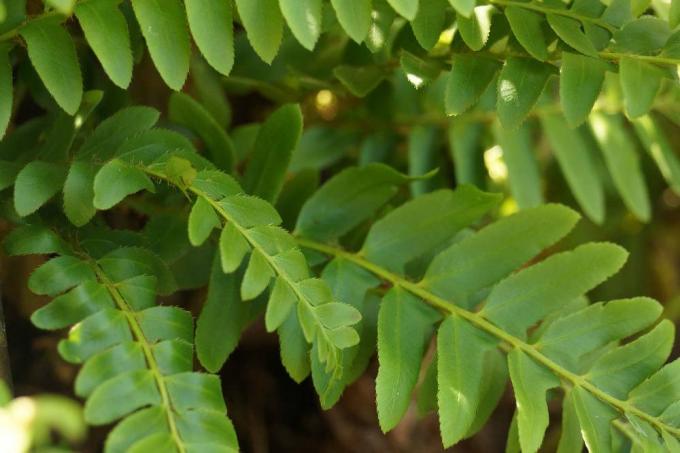
- Height: up to 120 cm
- Growth habit: forms clumps, forms strong runners
- Required space: 80 - 100 cm
- Flower: does not form flowers
- Leaves: bi-pinnate, dull, tapering to a point
- Soil: fresh, moist, well-drained, humic
Hardy plants such as the ostrich fern benefit from a shady location, because there is often snow there for longer. This protects the underground buds and prevents the plants from growing too early and possibly being damaged by late frosts.
Types of F - G
Hostas (Hosta spec.)

- Height: up to 50 cm
- Growth form: ground covering, branched
- Required space: 40 - 50 cm
- Flower: violet, bell-shaped
- Flowering period: June - July
- Leaves: egg-shaped, tapering to a point, depending on the variety, shades of green, yellow or variegated leaves
- Soil: humic, well-drained, fresh
Hostas are the ideal plants for a shady location. They only produce a flower under optimal conditions. Due to their leaves, which can have different colors depending on the variety, they are an eye-catcher in shady places.
Large-leaved lady's mantle (Alchemilla mollis)
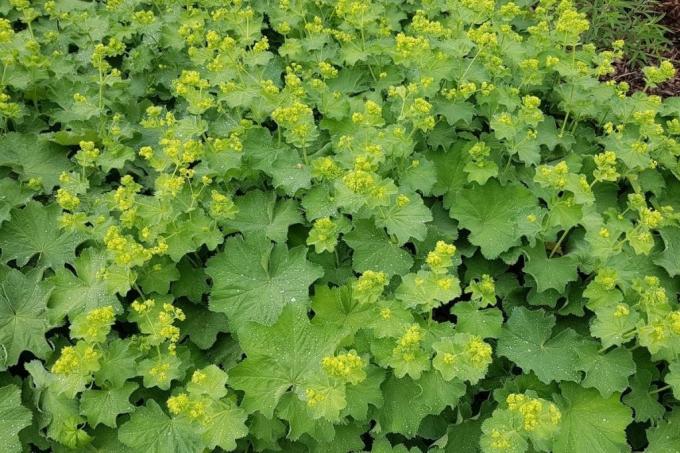
- Height: up to 40 cm
- Growth habit: clumpy, pillow-like
- Required space: 40 cm
- Flower: umbel-shaped, green-yellow
- Flowering period: June - July
- Leaves: rounded, serrated or lobed leaf margin
- Soil: fresh, well-drained
Species with H
Hanging golden bell (Uvularia grandiflora)

- Height: up to 60 cm
- Growth habit: forms clumps and rhizomes, arching
- Required space: 30 - 40 cm
- Flower: bell-shaped, yellow
- Flowering period: April - June
- Leaves: lanceolate, matt
- Soil: well drained, very humic
Autumn anemone (Anemone spec.)

- Height: up to 80 cm
- Growth habit: clumpy, spreading
- Required space: 35 cm
- Blossom: simple, white or purple depending on the variety
- Flowering period: August - October
- Leaves: tripartite, finely hairy
- Soil: well drained, nutritious, loamy, sandy
The autumn anemone is ideal for shady places and in autumn it creates a magical flower again. In good locations it blooms until the first frost.
Heart-leaved foam blossom (Tiarella cordifolia)

- Height: up to 20 cm
- Growth habit: carpet-like, flat
- Required space: 25 cm
- Flower: panicle-shaped, yellow-white
- Flowering period: April - May
- Leaves: round to heart-shaped, lobed, finely hairy
- Soil: fresh, humic, well-drained
The heart-leaved foam blossom is not only a decorative perennial, it also requires no maintenance. If you disturb plant residues, you can remove them, alternatively simply let them compost on the spot. This makes it suitable for planting difficult locations such as on slopes.
High forest goat's beard (Aruncus dioicus)
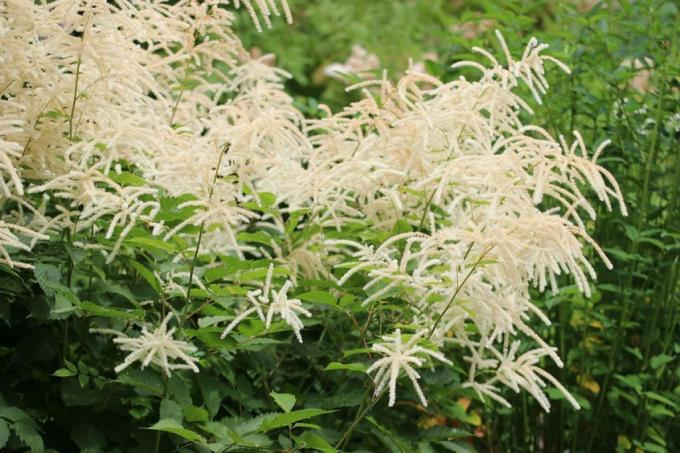
- Height: up to 180 cm
- Growth habit: spreading, clumpy
- Required space: 100 cm
- Blossom: simple, panicle-shaped, yellowish, white
- Flowering period: June - July
- Leaves: pinnate, dull, large
- Soil: well-drained, very nutritious, very humus
The high forest goat's beard is an ideal perennial for greening large, shady areas. It reaches an imposing height of almost two meters. Even when it has faded, the large leaves still cover the areas well. The flowers are also very popular with insects.
Types from I - R
Evergreen (Vinca spec.)

- Height: up to 30 cm
- Growth habit: spreading, forms many runners
- Space requirement: 30 cm, the formation of runners can quickly increase the space requirement
- Flower: simple, blue or white depending on the variety
- Flowering period: May - September
- Leaves: lanceolate, dark green
- Soil: well-drained, fresh, humic
Note: The periwinkle is the ideal plant for shady places. After a few years, the plants form a lush carpet of flowers and the leaves are green all year round.
Japanese sedge (Carex morrowii)

- Height: up to 40 cm
- Growth habit: clump-forming
- Required space: 30 - 50 cm
- Blossom: simple, spike-shaped, brown-yellow
- Flowering period: March - May
- Leaves: lanceolate, leathery, pointed
- Soil: well-drained, fresh, loamy, sandy
The Japanese sedge is also suitable for shady locations where it is drier. Compared to other grasses, this species does not form runners and the space requirement is constant, especially in the first few years. Should the Japanese sedge ever get too big, it is simply divided and the rest, which is too much, is removed.
Red Lungwort (Pulmonaria rubra)

- Height: up to 30 cm
- Growth habit: pillow-like
- Required space: 25 - 30 cm
- Flower: bell-shaped, red
- Flowering period: April - May
- Leaves: lanceolate, finely hairy
- Soil: fresh, moist, humic, loamy, sandy
Ice doesn't have many hardy plants that bloom early and are very attractive to insects. The red-flowered lungwort is a cultivated form of the native lungwort, which, however, has pure red flowers. The lungwort is also a very good ground cover that does not get very tall.
Types with S
Solomon's Seal (Polygonatum spec.)
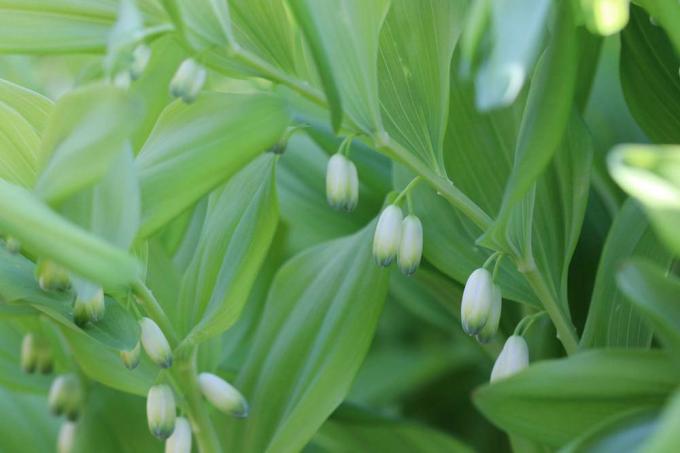
- Height: up to 60 cm
- Growth form: upright, overhanging
- Required space: 30 cm
- Blossom: racemose, small, white, bell-shaped single flowers
- Flowering period: May - June
- Leaves: green, ovate
- Soil: well drained, fresh
Shadow sedge (Carex umbrosa)

- Height: up to 20 cm
- Growth habit: cushion-like, forms clumps
- Required space: 20 - 25 cm
- Blossom: eared, red-brown
- Flowering period: April - May
- Leaves: lanceolate, pointed
- Soil: fresh, loamy, humic
The advantage of the shadow sedge is that it can be easily mowed with a lawnmower due to its early flowering time after flowering. Shady areas can be greened with it without any problems and the overhanging clumps look attractive all year round, even if you do not cut them after flowering.
Snakehead (Chelone obliqua)
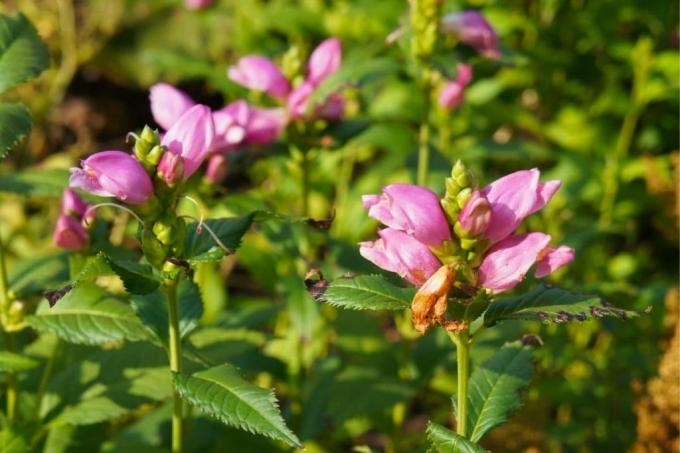
- Height: up to 150 cm
- Growth form: upright, moderately leafy
- Required space: 15 - 20 cm
- Flower: semi-double, pink - white, calyx-shaped
- Flowering period: July - September
- Leaves: broad, tapering, deep green
- Soil: humic, moist, neutral
The snakehead is a wildflower that is native to the United States. Although it prefers a shady location where it is constantly moist, it will also grow in sunny places if it is adequately supplied with water.
Sea feather rib fern (Blechnum penna-marina)
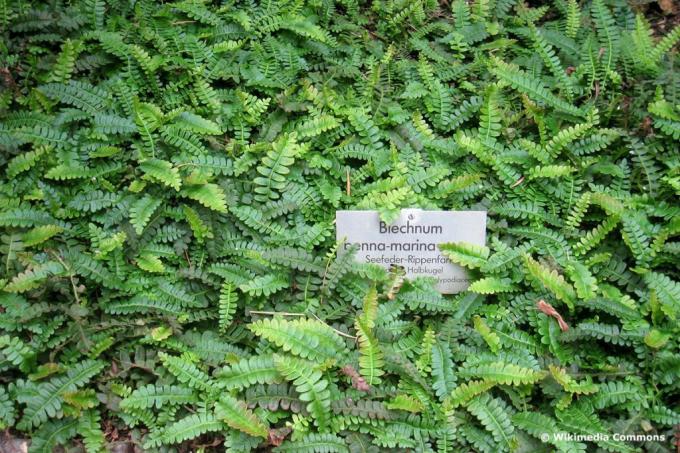
- Height: up to 30 cm
- Growth habit: branched, creeping
- Required space: 20 cm
- Flower: does not form flowers
- Leaves: pinnate leaves, rounded tips, lanceolate
- Soil: moist, fresh, loose
Tip: Grows in a shady location race mostly only sparse. The Seefeder Rib Fern is a suitable alternative to greening large areas in the shade, because you can mow it regularly like a lawn, which quickly forms a dense cover.
Types from T - Z
crying heart (Dicentra spectabili)
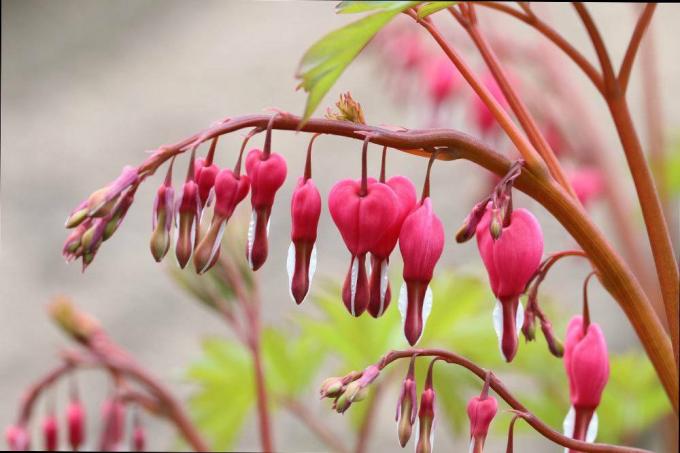
- Height: up to 80 cm
- Growth habit: upright, clumpy, spreading
- Required space: 75 cm
- Flower: heart-shaped, pink, white, reddish
- Flowering period: May - June
- Leaves: pinnate, blue-green
- Soil: fresh, humic, nutrient-rich, well-drained
Tip: The bleeding heart is particularly effective when planted in groups. You should plant a maximum of three perennials per square meter.
Forest ledge (Scirpus sylvaticus)
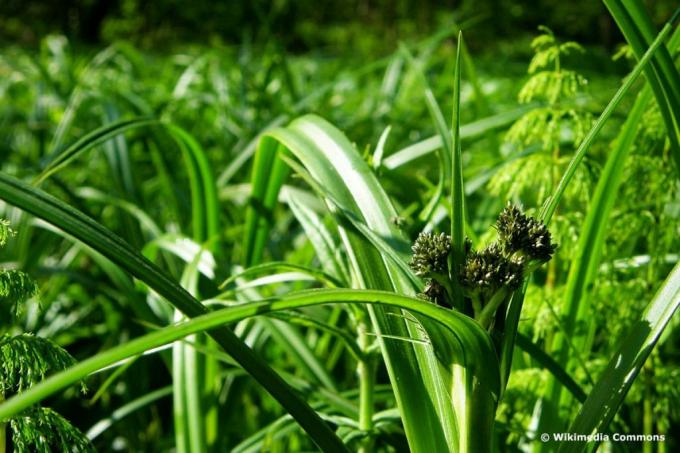
- Height: up to 60 cm
- Growth habit: clumpy
- Required space: 30 cm
- Flower: spike-shaped, brown, simple
- Flowering period: May - June
- Leaves: green, narrow, long, silvery ciliate on the edge
- Soil: humic, fresh, well-drained
Wolf's monkshood (Aconitum lycoctonum subsp. vulparia)
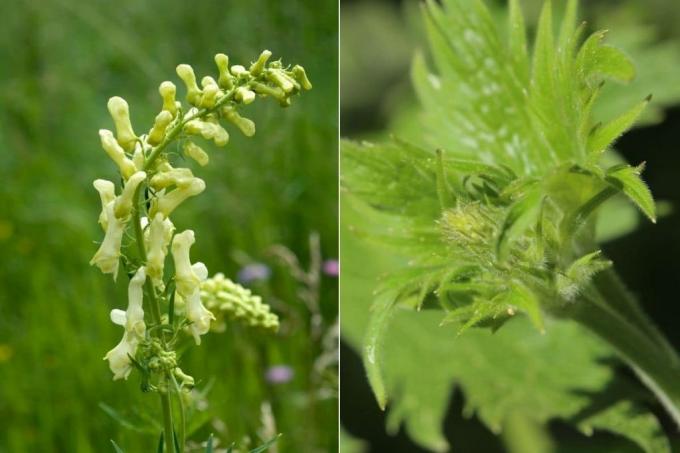
- Height: up to 80 cm
- Growth habit: upright flower stalks, clump-forming, basal leaf rosette
- Required space: 35 cm
- Blossom: racemose, pale yellow, simple
- Flowering period: July - August
- Leaves: shiny, deeply incised
- Soil: well drained, humus, rich in nutrients, slightly acidic
Fern (Dryopteris filix-mas)
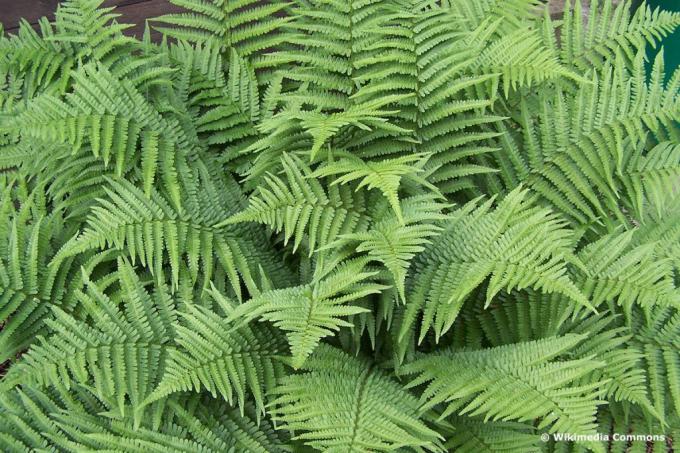
- Height: up to 90 cm
- Growth habit: clump-forming, upright, spreading
- Required space: 70 cm
- Flower: does not form flowers
- Flowering time: -
- Leaves: pinnate, lanceolate
- Soil: fresh, well-drained, very humus, rich in nutrients, slightly acidic
frequently asked Questions
Hardy plants that are suitable for shady locations can also be used for planting on slopes. They can even help secure those slopes that are at risk of slipping due to persistent moisture.
No, the opposite is often the case. Compared to other perennials, dead plant parts compost faster in shady locations due to the high humidity. This means that fewer leaves and stems need to be removed. The rapid composting has the advantage that it provides a lot of nutrients, which hardy plants also appreciate in shady places.
Due to the low light conditions, you should make sure that the plants do not take away the light from each other. Therefore, when choosing the plants, pay attention to the same height or staggered flowering times. Early bloomers usually do not mind if it is even more shady later, when they have already bloomed.
